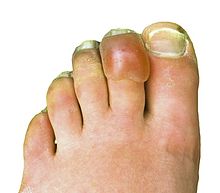
Back Vriesbrand Afrikaans قضمة الصقيع Arabic Conxelamientu AST Donma Azerbaijani Тән туңыу Bashkir Абмаражэнне Byelorussian Абмаражэньне BE-X-OLD Измръзване Bulgarian হিমদংশন Bengali/Bangla Goañvenn Breton
| Frostbite | |
|---|---|
| Other names | Frostnip |
 | |
| Frostbitten toes two to three days after mountain climbing | |
| Specialty | Dermatology, emergency medicine, orthopedics |
| Symptoms | Numbness, feeling cold, clumsiness, pale color[1] |
| Complications | Hypothermia, compartment syndrome[2][1] |
| Types | Superficial, deep[2] |
| Causes | Temperatures below freezing[1] |
| Risk factors | Alcohol, smoking, mental health problems, certain medications, prior cold injury[1] |
| Diagnostic method | Based on symptoms[3] |
| Differential diagnosis | Frostnip, pernio, trench foot[4] |
| Prevention | Avoid cold, wear proper clothing, maintain hydration and nutrition, stay active without becoming exhausted[2] |
| Treatment | Rewarming, medication, surgery[2] |
| Medication | Ibuprofen, tetanus vaccine, iloprost, thrombolytics[1] |
| Frequency | Unknown[5] |
Frostbite is a skin injury that occurs when exposed to extremely low temperatures, causing the freezing of the skin or other tissues,[1] commonly affecting the fingers, toes, nose, ears, cheeks and chin areas.[6] Most often, frostbite occurs in the hands and feet.[7][8] The initial symptoms are typically a feeling of cold and tingling or numbing.[1] This may be followed by clumsiness with a white or bluish color to the skin.[1] Swelling or blistering may occur following treatment.[1] Complications may include hypothermia or compartment syndrome.[2][1]
People who are exposed to low temperatures for prolonged periods, such as winter sports enthusiasts, military personnel, and homeless individuals, are at greatest risk.[7][1] Other risk factors include drinking alcohol, smoking, mental health problems, certain medications, and prior injuries due to cold.[1] The underlying mechanism involves injury from ice crystals and blood clots in small blood vessels following thawing.[1] Diagnosis is based on symptoms.[3] Severity may be divided into superficial (1st and 2nd degree) or deep (3rd and 4th degree).[2] A bone scan or MRI may help in determining the extent of injury.[1]
Prevention consists of wearing proper, fully-covering clothing, avoiding low temperatures and wind, maintaining hydration and nutrition, and sufficient physical activity to maintain core temperature without exhaustion.[2] Treatment is by rewarming, by immersion in warm water (near body temperature) or by body contact, and should be done only when consistent temperature can be maintained so that refreezing is not a risk.[2][1] Rapid heating or cooling should be avoided since it could potentially cause burning or heart stress.[9] Rubbing or applying force to the affected areas should be avoided as it may cause further damage such as abrasions.[2] The use of ibuprofen and tetanus toxoid is recommended for pain relief or to reduce swelling or inflammation.[1] For severe injuries, iloprost or thrombolytics may be used.[1] Surgery is sometimes necessary.[1] Amputation should be considered a few months after exposure in order to consider whether the extent of injury is permanent damage and thus necessitates drastic treatment.[2]
Evidence of frostbite occurring in people dates back 5,000 years.[1] Evidence was documented in a pre-Columbian mummy discovered in the Andes.[7] The number of cases of frostbite is unknown.[5] Rates may be as high as 40% a year among those who mountaineer.[1] The most common age group affected is those 30 to 50 years old.[4] Frostbite has also played an important role in a number of military conflicts.[1] The first formal description of the condition was in 1813 by Dominique Jean Larrey, a physician in Napoleon's army, during its invasion of Russia.[1]
- ^ a b c d e f g h i j k l m n o p q r s t u v Handford, C; Thomas, O; Imray, CHE (May 2017). "Frostbite". Emergency Medicine Clinics of North America. 35 (2): 281–299. doi:10.1016/j.emc.2016.12.006. PMID 28411928.
- ^ a b c d e f g h i j McIntosh, Scott E.; Opacic, Matthew; Freer, Luanne; Grissom, Colin K.; Auerbach, Paul S.; Rodway, George W.; Cochran, Amalia; Giesbrecht, Gordon G.; McDevitt, Marion (1 December 2014). "Wilderness Medical Society practice guidelines for the prevention and treatment of frostbite: 2014 update". Wilderness & Environmental Medicine. 25 (4 Suppl): S43–54. doi:10.1016/j.wem.2014.09.001. ISSN 1545-1534. PMID 25498262.
- ^ a b Singleton, Joanne K.; DiGregorio, Robert V.; Green-Hernandez, Carol (2014). Primary Care, Second Edition: An Interprofessional Perspective. Springer Publishing Company. p. 172. ISBN 9780826171474.
- ^ a b Ferri, Fred F. (2017). Ferri's Clinical Advisor 2018 E-Book: 5 Books in 1. Elsevier Health Sciences. p. 502. ISBN 9780323529570.
- ^ a b Auerbach, Paul S. (2011). Wilderness Medicine E-Book: Expert Consult Premium Edition - Enhanced Online Features. Elsevier Health Sciences. p. 181. ISBN 978-1455733569.
- ^ "Frostbite - Symptoms and causes". Mayo Clinic. Retrieved 19 February 2021.
- ^ a b c Handford, Charles; Buxton, Pauline; Russell, Katie; Imray, Caitlin EA; McIntosh, Scott E; Freer, Luanne; Cochran, Amalia; Imray, Christopher HE (22 April 2014). "Frostbite: a practical approach to hospital management". Extreme Physiology & Medicine. 3: 7. doi:10.1186/2046-7648-3-7. ISSN 2046-7648. PMC 3994495. PMID 24764516.
- ^ Millet, John D.; Brown, Richard K. J.; Levi, Benjamin; Kraft, Casey T.; Jacobson, Jon A.; Gross, Milton D.; Wong, Ka Kit (November 2016). "Frostbite: Spectrum of Imaging Findings and Guidelines for Management". Radiographics. 36 (7): 2154–2169. doi:10.1148/rg.2016160045. ISSN 0271-5333. PMC 5131839. PMID 27494386.
- ^ "Frostbite and Hypothermia". CT.gov - Connecticut's Official State Website. Retrieved 2 July 2021.
© MMXXIII Rich X Search. We shall prevail. All rights reserved. Rich X Search